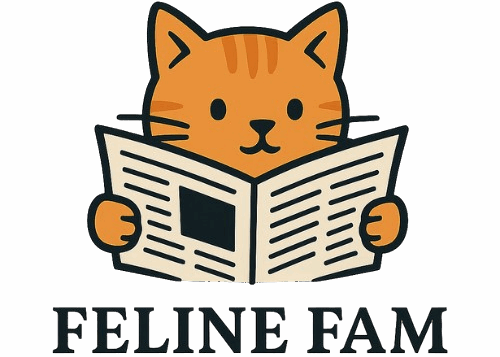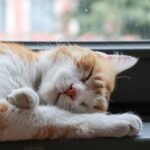Have you ever stared at your cat’s tail, wondering what secret message it’s sending you? Imagine if you could decode every flick, twitch, and swoosh—like cracking a secret language only your cat knows. The truth is, a cat’s tail is a non-stop communication device, broadcasting their moods, intentions, and feelings with every movement. For cat lovers, learning to read this unique “tail talk” is like unlocking a hidden world. Whether your feline friend is plotting a pounce or just wants a cuddle, their tail is the first to tell. Let’s take a deep dive into the mysterious, mesmerizing world of feline tails—and discover how to read a cat’s tail like a true pro.
The High Tail: A Confident Cat in Action

When a cat walks into the room with its tail held high, it’s putting on a show of self-assurance. This upright tail is the feline equivalent of a proud strut. A high tail signals confidence, friendliness, and curiosity. You’ll often see this when your cat greets you at the door or explores a familiar space. It’s their way of announcing, “I’m happy to be here!” Cats with high tails are generally relaxed and ready for interaction, so it’s a green light for petting or playtime. This posture is also contagious—seeing that tail up can make any cat lover smile. Just be aware: a high, quivering tail can mean excitement or even a readiness to spray in unneutered males, so context matters.
The Puffed-Up Tail: Fear and Surprise in Full Display

A tail that suddenly fluffs up into a bottle brush isn’t just for show—it’s pure instinct. This dramatic display usually means your cat is startled, scared, or trying to appear larger in the face of a threat. It’s like putting on a superhero costume, hoping the “enemy” will back down. You might witness this during loud noises, unexpected guests, or a tense moment with another animal. The puffed-up tail is often accompanied by an arched back and sideways stance, a classic Halloween-cat pose. If you see your cat like this, give it space—comfort will come later. It’s a real-life example of how cats wear their hearts on their tails.
The Low Tail: Uncertainty or Submission

A tail that droops low or trails along the ground is sending a quieter message. Cats with low tails are often feeling insecure, uncertain, or even submissive. This position can occur during introductions to new environments or when a more dominant animal is nearby. It’s their way of saying, “I’m not looking for trouble.” Sometimes, illness or discomfort can cause a cat to lower its tail, so keep an eye on any sudden changes. If you notice your usually spirited cat with a tail dragging behind, a little extra care and patience go a long way. Think of it as your cat’s subtle SOS for support.
The Tucked Tail: Anxiety and Fear

A tail tightly tucked under the body is practically shouting, “I’m scared!” This is one of the most universal feline distress signals. Cats use this position to make themselves smaller and less noticeable, usually in stressful situations. It’s common during vet visits, thunderstorms, or after a household squabble. The tucked tail can be heartbreaking to see, especially when paired with flattened ears and wide eyes. If your cat adopts this posture, offer reassurance, but don’t force interaction. It’s a reminder that even the bravest cats need comfort sometimes. Sometimes, just sitting quietly nearby can help them feel safe again.
The Swishing Tail: Annoyance and Agitation

When your cat’s tail starts swishing back and forth, pay attention—this is classic cat irritation. Fast, sharp movements often mean your feline is annoyed, overstimulated, or about to pounce. You might see this during play, just before a “love bite,” or if you’re petting a sensitive spot for too long. It’s almost like your cat’s way of waving a warning flag: “Back off, I need space!” Swishing tails can also appear when your cat is watching birds or bugs outside, full of predatory excitement. Knowing when to stop and give them room can save your hands from a surprise swipe.
The Slow Wag: Deep Concentration or Mild Irritation

Not all tail movement is dramatic. A slow, deliberate wag from side to side is a sign your cat is deep in thought, focused, or slightly annoyed. This motion is much subtler than the fast swish of irritation. It often happens when your cat is stalking prey (even if it’s just a toy mouse) or watching something intently. Sometimes, it can mean they’re weighing their options: pounce or stay put? It’s like watching someone tap a pencil while thinking hard. If you see this tail language, know your cat is in their own world—respect their focus, and you’ll be rewarded with trust.
The Quivering Tail: Pure Excitement

A tail that quivers like a vibrating string announces pure feline excitement. This can happen when your cat greets you after a long day or when they’re about to receive their favorite treat. It’s their way of saying, “I’m thrilled to see you!” In some cases, especially with unneutered males, quivering can also indicate territorial marking, but with most house cats, it’s just joy. You’ll spot this behavior by the front door, during meal prep, or when you shake the treat bag. It’s impossible not to smile when your cat’s tail vibrates with happiness.
The Wrapped Tail: Affection and Comfort

Few things are more heartwarming than a cat curling its tail around your hand, arm, or another cat. This gentle gesture is a sign of affection and trust. When cats wrap their tails around people, they’re treating you like family—literally including you in their social circle. You’ll also see this when cats curl up together, tails intertwined in a fuzzy embrace. It’s their way of saying, “You belong with me.” This tail talk is the feline version of a hug, so cherish it whenever it happens. It’s the ultimate compliment from your whiskered companion.
The Question Mark Tail: Playful Curiosity

A tail that arches at the tip, forming a loose question mark, is a sign your cat is feeling playful and content. This quirky shape often appears during happy greetings or when your cat is exploring something new. It’s their way of saying, “What’s next?” This posture is an invitation to interact, so grab a toy or offer a gentle scratch. The question mark tail signals a cat in a perfect mood—relaxed but curious, ready for fun but open to affection. If you see this tail shape, it’s the ideal time to bond and play.
The Straight-Out Tail: Alert and Interested

When a cat’s tail sticks straight out, not too high or low, it’s a sign of alertness and interest. This is a neutral, watchful position—like pausing mid-step to check out what’s happening. Cats use this posture when assessing a new situation, meeting another animal, or deciding whether to engage or retreat. It’s their way of saying, “I’m paying attention.” The straight-out tail is an important cue for owners, signaling a moment of decision. Watch for what happens next, because your cat is weighing its options and you’re about to witness their next move.
The Twitching Tip: Heightened Attention

That tiny, quick twitch at the end of your cat’s tail is a telltale sign of focused attention or excitement. You’ll often notice it when your cat is staring out the window at birds or tracking a bug across the floor. It’s like the feline version of drumming your fingers in anticipation. This little movement is part of their hunting instinct, signaling that every muscle is ready for action. Sometimes, the twitching tip can also mean mild irritation if paired with flattened ears or narrowed eyes. Context is key, but generally, a twitching tip means your cat is fully engaged.
The Lazy Flick: Relaxed and Unbothered

A gentle, lazy flick of the tail is a sign of a relaxed, content cat. You’ll see this when your cat is sprawled in a sunny spot, watching the world go by without a care. The slow, rhythmic movement is almost hypnotic—like a metronome marking the beat of a peaceful afternoon. Unlike the rapid swish of annoyance, this tail talk says, “I’m happy and unbothered.” If your cat’s tail is flicking softly, you can rest easy knowing they feel safe and at home. It’s a small, silent thank you for providing a cozy haven.
The Hooked Tail: Slight Hesitation

Sometimes, a cat’s tail will hook downward at the end, creating a gentle bend. This subtle position usually means your cat is unsure or hesitant about something. They might be deciding whether to approach a new person, investigate a strange object, or enter a new room. The hooked tail is an in-between signal—not quite relaxed, not fully tense. It’s as if your cat is saying, “I’m curious, but I’m not sure yet.” Give them time and space, and let their confidence grow at their own pace. Patience is key in building trust during these moments.
The Tail Draped Over Another Cat: Bonding and Friendship

When two cats are comfortable enough to rest together with one’s tail draped over the other, you’re witnessing a beautiful display of feline friendship. This gesture is more than just physical contact—it’s a sign of deep trust and social bonding. Cats in multi-pet households use this tail talk to reinforce their connection and show that they feel safe together. If you see your cats sharing this moment, it means you’ve created a peaceful, loving environment. It’s the cat version of holding hands, and it’s a privilege to witness such genuine affection.
Reading Tail Language in Kittens: Early Clues

Kittens start using tail signals almost from the moment they learn to walk. Their tiny tails shoot up in excitement, puff up in surprise, and curl around siblings for warmth and comfort. Paying attention to kitten tail language is a fantastic way to bond early and understand their unique personalities. Kittens are more dramatic and less subtle than adult cats, making their tail talk easy—even adorable—to interpret. Watching a room of kittens can be like seeing a silent movie, full of exaggerated gestures and emotions. By learning to read these early signals, you set the stage for a lifelong, trusting relationship.
Tail Language Across Different Breeds

Not all tails are created equal—some cats have long, graceful tails, while others sport short or kinked ones. Different breeds can express themselves in unique ways, but the core messages are surprisingly consistent. For example, a Maine Coon’s bushy tail may seem more expressive, while a Manx with no tail relies more on posture and other body language. Understanding your cat’s breed-specific quirks helps you become a true tail-reading expert. No matter the shape or size, every cat uses its tail to speak—and once you learn to listen, you’ll never see your feline friend the same way again.

Linnea is a born and bred Swede but spends as much time as possible in Cape Town, South Africa. This is mainly due to Cape Town’s extraordinary scenery, wildlife, and atmosphere (in other words, because Cape Town is heaven on earth.) That being said, Sweden’s majestic forests forever hold a special place in her heart. Linnea spends as much time as she can close to the ocean collecting sea shells or in the park admiring puppies.






